WEnRV travel news, products, and industry trends
The Ultimate Arizona Road Trip
Though Arizona might be best known for its giant crack in the earth, the Grand Canyon State offers boundless opportunities to experience some of the most unique landscapes in the country. From towering saguaros, colorful canyons and ancient cliff dwellings to kitschy Route 66 attractions and relics of the Old West, Arizona is chock-full of places to explore.
Page and Marble Canyon

The Navajo Bridge crosses the Colorado River near Lee’s Ferry.
Situated along Arizona’s northern border, the town of Page provides the perfect basecamp for exploring this region of the state. Take the scenic drive south from Page to Marble Canyon, home of the Navajo Bridge that spans the Colorado River. While there, explore Lee’s Ferry, the principal launching point for Grand Canyon rafters, and hike along the interpretive trail featuring ruins from the old settlement. For a longer trek, hike the Cathedral Wash Trail that takes you through a beautiful slot canyon with spectacular geology. While in Page, stop at Horseshoe Bend for an iconic view of the Colorado River and explore the Lake Powell area.
Prescott and Jerome
Not far from Sedona and along scenic 89A, you’ll find the historic mountaintop town of Jerome. This former copper mining town-turned-artist colony is also known for its haunts and ghost tours. Explore the place once regarded “Wickedest Town of the West” on guided trips that allow exclusive access to several historic buildings. While walking around the community, peruse the quirky galleries and boutiques that line the streets and drop by the Mining Museum. Because of the winding nature of this high-elevation segment of 89A, with 127 curves in 12 miles, it’s fair to say this is a destination where the trailer is best left-back at camp.
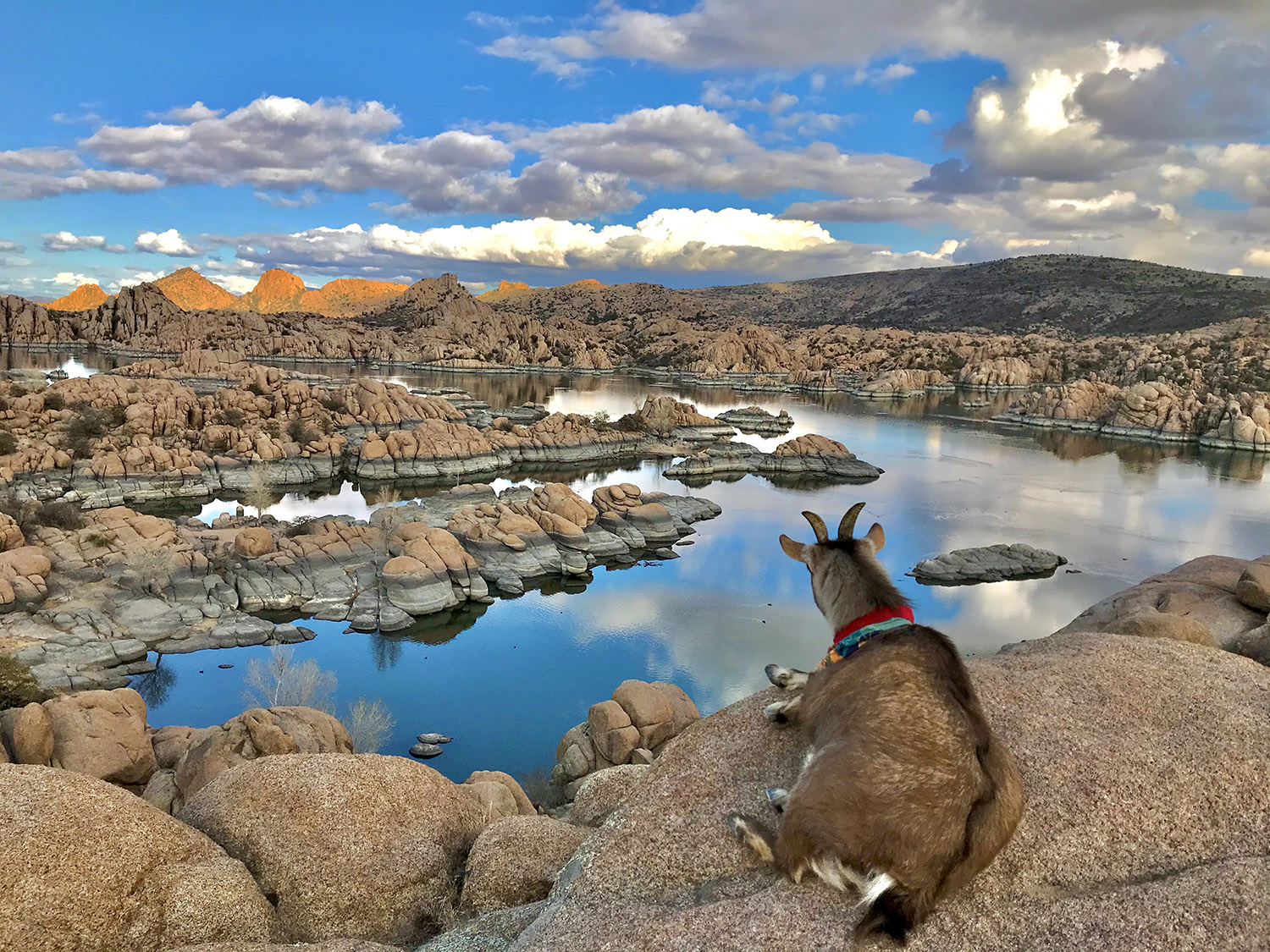
Frankie the goat takes in the views at Watson Lake in Prescott
Prescott (pronounced, “Press-kit), the original capital of the Arizona Territory, is full of cowboy charm and Old West landmarks in addition to its gorgeous scenery. Like Jerome, this higher-elevation destination is a great place to escape the heat while exploring its granite peaks, crystal lakes and vast ponderosa pine forests. During your visit, hike the pet-friendly loop trail around Watson Lake or the panoramic trail on Granite Mountain. In downtown’s historic district, drop by Whiskey Row, where you’ll find dozens of lively bars, including the Palace Restaurant & Saloon, Arizona’s oldest establishment. That’s not the only historic claim to fame — Prescott is also home to the world’s oldest Rodeo, and during “Frontier Days,” the town celebrates with parades, dances and Old West events.
Sedona

Chapel of the Holy Cross is built into the red rock.
It’s been said that people gravitate to Sedona’s Red Rock Country not only for its beauty but also for its famed vortex zone. This mecca for healers attracts people from all over the world, who visit Sedona to recharge, relax and improve their wellness. With numerous outdoor opportunities, countless restaurants and dozens of art galleries, the town offers a little bit for everyone to enjoy. Some popular hiking trails include Cathedral Rock, Boynton Canyon, Devil’s Bridge and Bell Rock, but get there as early as possible to avoid the crowds. Visit the stunning Chapel of the Holy Cross, designed by famed architect Marguerite Brunswig Staude, a pupil of Frank Lloyd Wright.
Superstition Mountains
With their jagged volcanic peaks, the Superstition Mountains just east of Phoenix dramatically rise above the desert floor, providing a natural playground for outdoor adventurers. Between rock-climbing, hiking, canyoneering, boating and biking, the area is chockful of recreational opportunities. Shrouded in mystery, the Superstition Mountains are home to many local myths, from Native American legends to that of the Lost Dutchman, an immigrant who discovered gold and purportedly buried his treasure in the mountains. To this day, no one has found the valuable cache. While visiting, explore old movie sets at the Superstition Mountain Museum and hike the trails at Lost Dutchman State Park.
Grand Canyon National Park

The Grand Canyon’s South Rim trail is one of the few pet-friendly trails in the park.
Bigger in area than the state of Rhode Island, the Grand Canyon is more than a mile deep and measures over 1,902 square miles in its entirety. This giant chasm exposes more than two billion years of geological history and is considered one of the Seven Natural Wonders of the World. While planning a trip during the spring through fall, the North Rim offers visitors relief from the massive influx of tourists seen at the more developed South Rim. This higher elevation section of the national park is sprawling with beauty and panoramic views. While there, take the 11-mile scenic drive from the visitor center to Point Imperial, the highest rim overlook at 8,803 feet. Take the short hike to Bright Angel Point and Cape Royal, the widest panoramic vista at the Grand Canyon, where you can also view Angels Window, a natural arch made of Kaibab limestone.
Located near Flagstaff, the South Rim is more centrally located than its northern counterpart and is easily accessible year-round. Drop by the state-of-the-art visitor center and hike along the South Rim trail, the only pet-friendly trail with canyon views.
For those who have extra time to spare and enjoy adventure, plan a backpacking, rafting or mule trip down into the canyon.
Montezuma’s Castle National Monument
For a peek into the past, plan a visit to Montezuma’s Castle, a five-story, 20-roomed cliff dwelling centrally located between Sedona and Phoenix. This indigenous apartment complex was built and used by the Sinagua people, the ancient ancestors of present-day Pueblo tribes of Arizona. To see additional villages in Arizona left behind from the Sinagua, visit Tuzigoot, Walnut Canyon and Wupatki National Monuments.
Organ Pipe National Monument

In addition to its namesake cactus, Organ Pipe National Monument is home to over 550 species of vascular plants.
Straddling the Arizona/Mexico border, Organ Pipe National Monument is the only place in the country you can see the organ pipe cactus grow in abundance. With only a fraction of Saguaro National Park’s visitation, Organ Pipe is the perfect spot to escape the crowds and explore the best of the Sonoran Desert. The ideal time to visit is late fall to early spring, while the temperatures are pleasant. Drive the Ajo Mountain Scenic Route, a 21-mile gravel road with plenty of pull-offs for picture taking. While on your motor tour, enjoy the abundant organ pipe, saguaro, cholla and ocotillos that cover the desert floor. One of the best hikes is the Double Arches Trail that takes you through Arch Canyon, which can be seen near the halfway point along Ajo Scenic Drive. There are few supplies nearby and groceries are limited, so make sure to stock up before arrival.
Meteor Crater
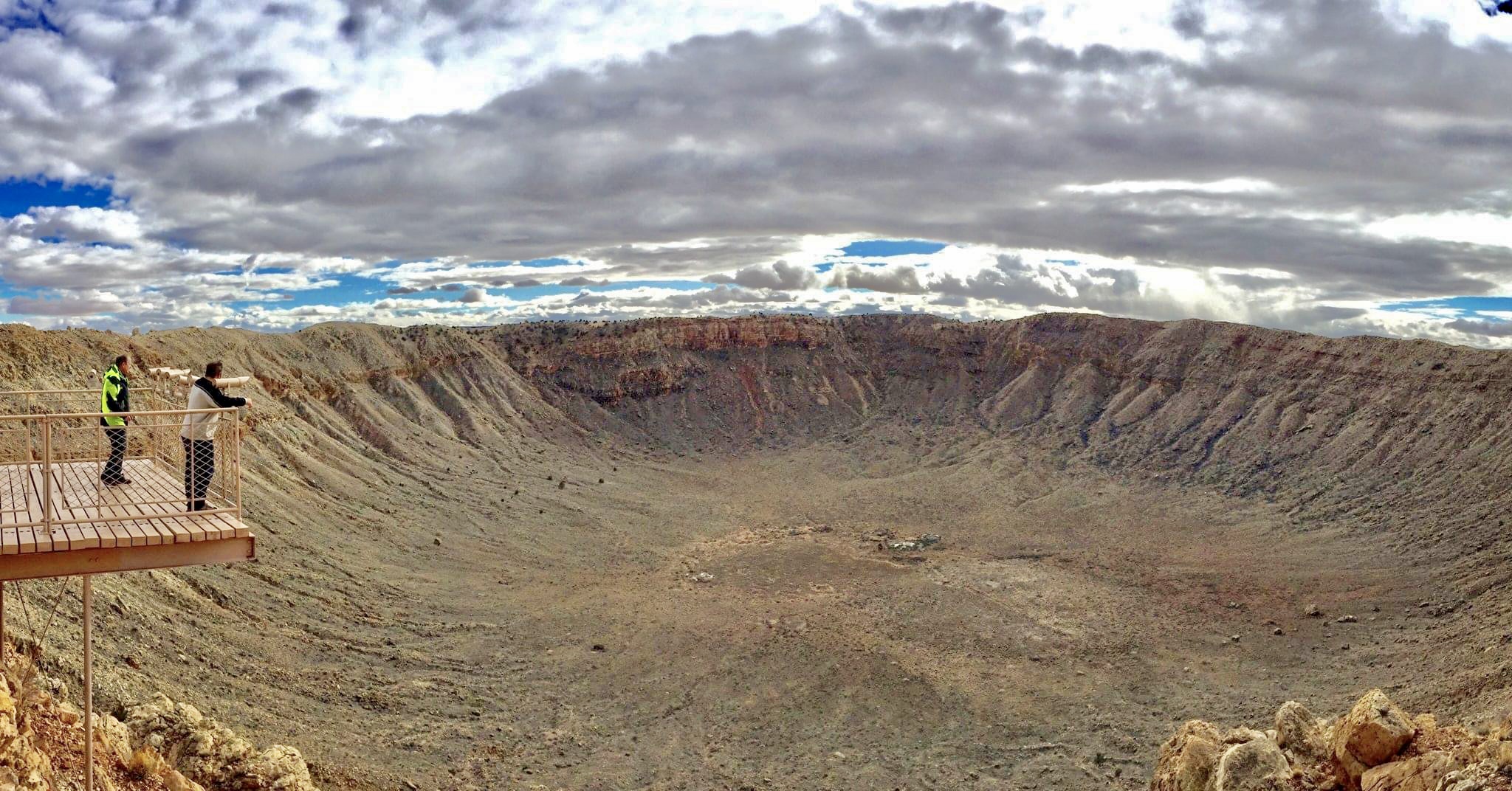
Meteor Crater’s observation deck offers great views of the rugged ground below.
Formed 50,000 years ago when an asteroid crashed into what is now central Arizona, Meteor Crater is the best-preserved impact crater on Earth. Traveling 8-miles per second, the 150-foot-diameter asteroid left a crater measuring 3,900 feet across. While there, walk on the observation deck for a birds-eye view of the massive hole in the ground or take the guided 2.4-mile trail around the crater’s rim.
Kofa Wildlife Refuge

Walk the labyrinth along the road to Palm Canyon.
Not far from Organ Pipe is Kofa Wildlife Refuge, a protected haven in the remote desert encompassing more than 665,000 acres. The site was designated to protect the Bighorn sheep, but it also attracts rockhounds, hikers, wildlife photographers and stargazers. Not only is it a safe haven for wildlife, but it’s also a quiet winter escape from the crowds down the road at Quartzsite. While visiting the area, hike to Palm Canyon and walk the labyrinth, located just off the dirt road to the canyon.
Route 66

Before I-40, Route-66 was the primary route for those traveling West.
The famed Mother Road stretches across Arizona as it makes its way from Chicago to the Santa Monica pier, passing badlands, volcanic craters, petrified forests and stark plateaus. The road tells the tale of a bygone era, and though a good portion of it is now dust in the wind, there are many notable stops that are worthy of a trip down memory lane. With over 250 drivable miles, you’ll find scores of iconic Route 66 highlights in the Copper State, including Holbrook’s Wigwam Motel, Williams’ neon signs and Oatman’s wild burros. Get a photo-op on the corner in Winslow, Arizona and with offbeat roadside attractions like the Rock Shop Dinosaurs in Holbrook. While following Route-66, also enjoy the natural gems scattered along drives like Sunset Crater Volcano National Monument, the Painted Desert and the Petrified Forest National Monument.
Bisbee
Located Southeast of Tucson, the thriving artist town in the Mule Mountains came to prominence in the 1800s for its famed mining operations. Dubbed the “Queen of the Copper Camps,” Bisbee proved to be one of the richest mineral sites in the world, producing over 8 billion pounds of copper, and 3 million ounces of gold in addition to silver and zinc. By the early 1900s, Bisbee was the largest city between San Francisco and St. Louis. Today, enjoy the many eclectic galleries and boutiques that line the colorful streets, tour the famed Queen Mine and have a cold one at Old Bisbee Brewing Company.
Saguaro National Park
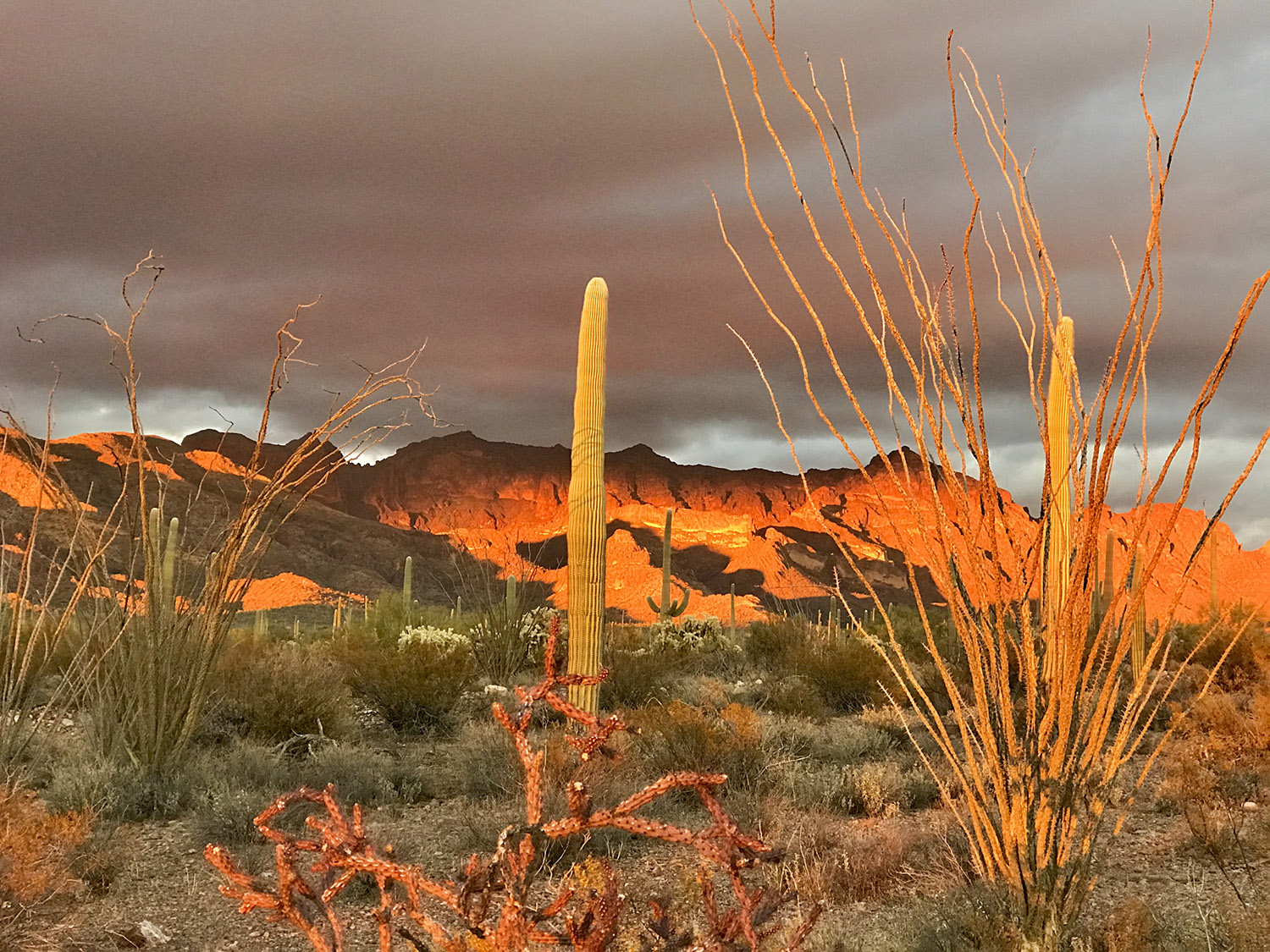
The Sonoran Desert is the only place on Earth the saguaro cactus grows.
Named after its signature cactus, Saguaro National Park outside of Tucson is a desert landscape brimming with life. With more than 1.6 million saguaro plants and countless other species of flora within the park boundaries, this area is a stunning landscape, especially when it’s in bloom. The park is split into two districts: The western division is known as the Tucson Mountain District, which is hotter and drier, while the larger Rincon Mountain District to the East is cooler and wetter. Take the 5-mile Scenic Bajada Loop Drive through a dense saguaro forest that offers beautiful mountain views and hike the Signal Hill and Valley View Overlook trails. For a pet-friendly hike just outside of the park, take the crowd-free Cocoraque Butte trail in the Ironwood Forest, which brings you to an excellent petroglyph site.
Chiricahua National Monument
Tucked away in the Southeastern corner of the state, Chiricahua National Monument is a hidden gem comprised of hoodoos, towering pinnacles, and diverse flora and fauna. The unique volcanic rock formations date back over 27 million years, when the Turkey Creek Caldera erupted, depositing 2,000 feet of ash in the region and forming the Chiricahua Mountains. Over time, the tuff eroded from the elements, leaving behind a wonderland of rocks. While visiting, hike along the 17-miles of trails within the park and take the 8-mile scenic drive to Massai Point for panoramic views of the mountain range. Being an island in the sky, stargazers can enjoy an ultrabright Milky Way as the park has little light pollution.
Monument Valley
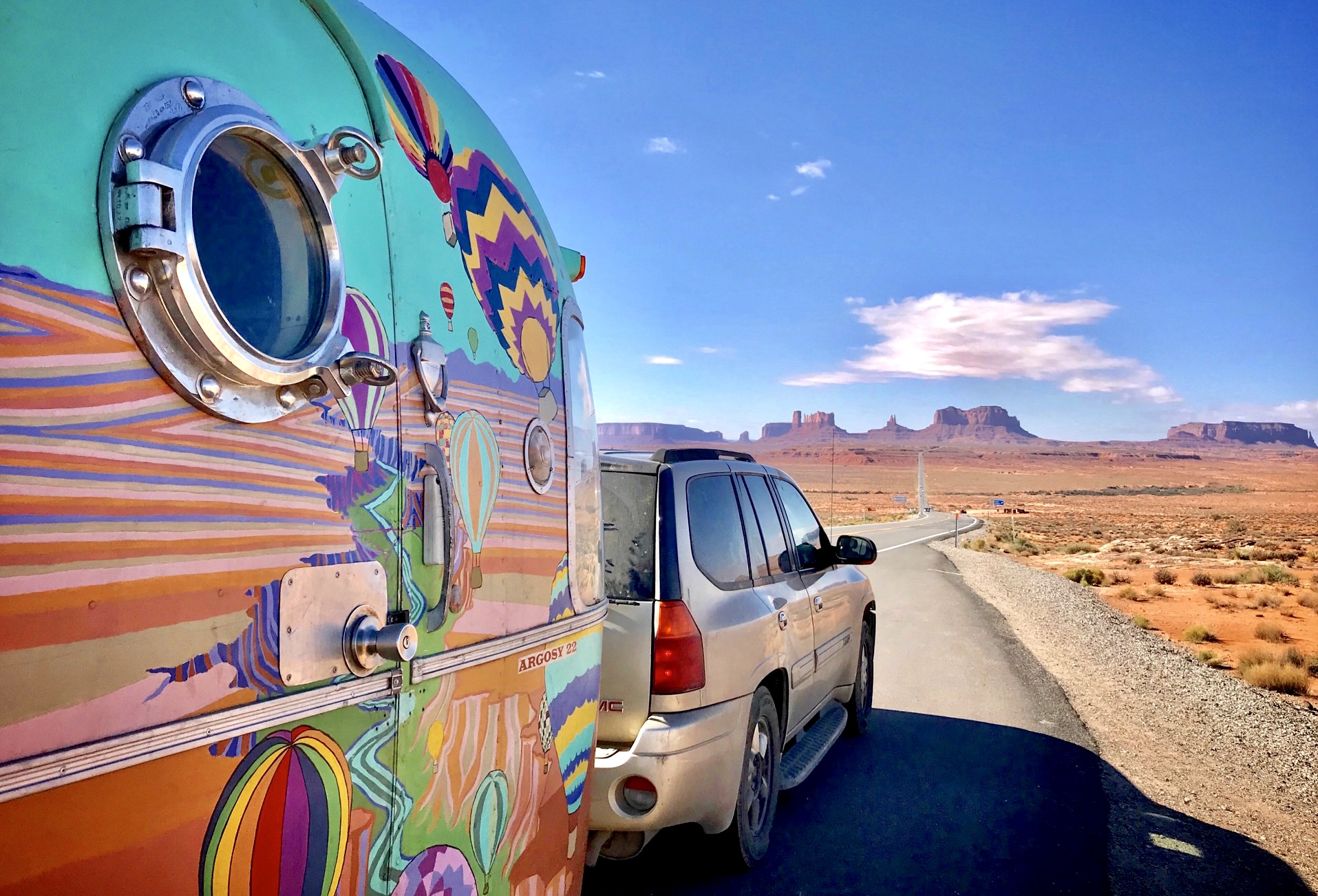
For one of the most iconic views of Monument Valley, drop by the Forrest Gump Point.
Without a doubt, Monument Valley is one of the most recognized natural landscapes in the country. With towering monoliths and buttes rising sharply over the desert floor, this colorful setting straddles the Arizona/Utah state line. To explore by car, enter the Navajo Tribal Park and take the scenic loop drive to many of its stunning overlooks. For those who want to see where Forrest Gump turned around during his trek across the country during the 1994 movie of the same name, stop at the pull-off around mile 13 along Highway 163 for a photo op.
Cosanti and Arcosanti
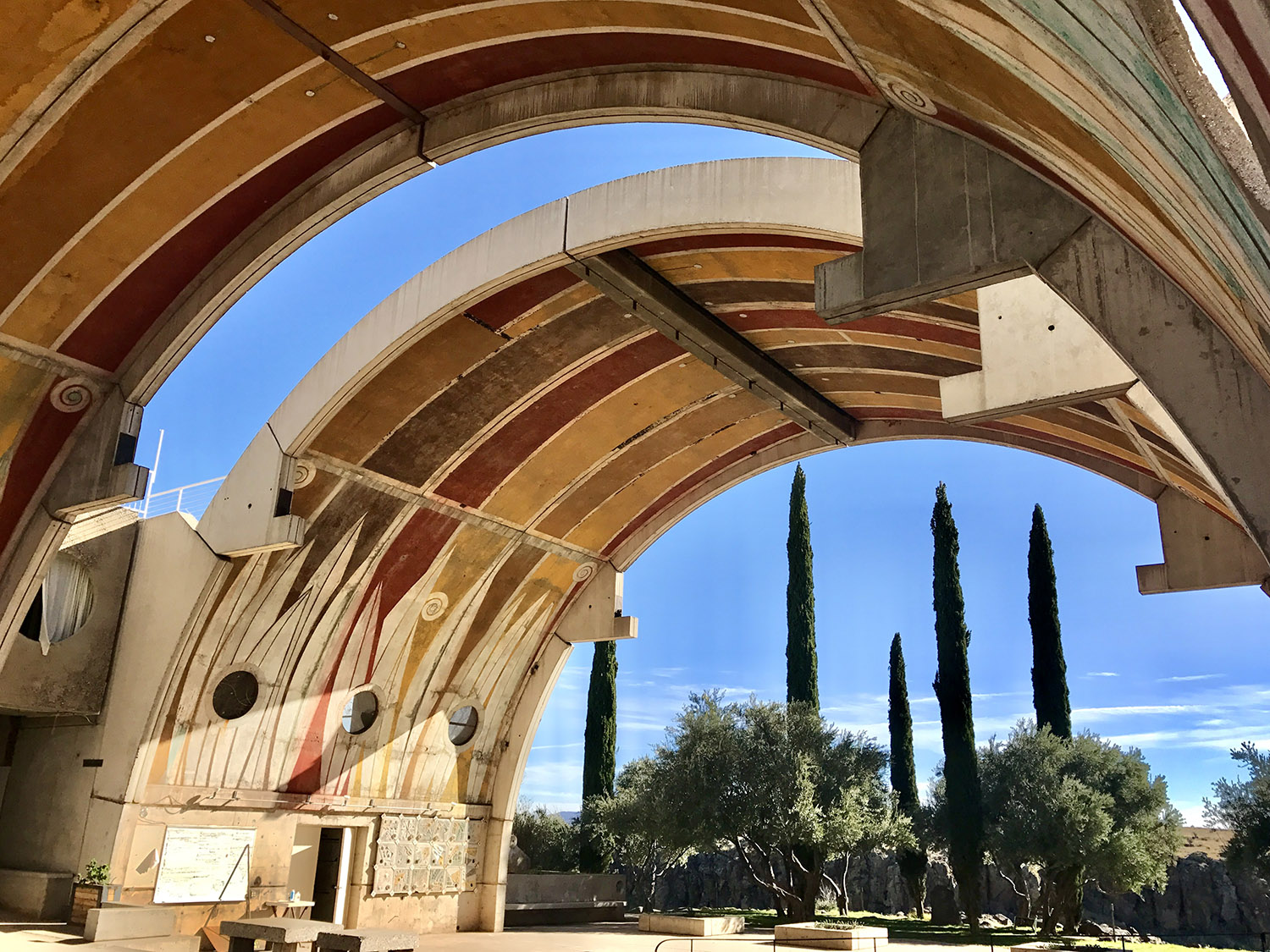
Today, visitors can tour Arcosanti and Cosanti free of charge, but donations to the organization are encouraged.
Built by famed Italian architect, Paolo Soleri, Cosanti is one of Arizona’s most eclectic historic sites. After studying under Frank Lloyd Wright, Soleri became known for designing experimental earth-formed concrete structures, integrating architecture and ecology. Cosanti, located near Scottsdale in Paradise Valley, was his residence and his first attempt at creating a space where people could live and work while making a minimal impact on the surrounding natural environment. Like the Earthships of New Mexico, his organic architecture was about harmonizing with nature. About an hour north of Phoenix is Arcosanti, a sustainable living project started by Soleri, that was built to be the answer to urban sprawl. Today, you can tour both sites and donations to the organization are encouraged.
Canyon de Chelly
This area is recognized as one of the longest continually inhabited landscapes in North America. For nearly 5,000 years, people have lived in these sacred canyons located near the Four Corners. The Canyon de Chelly National Monument lies on Navajo land and is known for its dramatic sandstone-walled canyons, Puebloan cliff dwellings and ancient petroglyphs. While visiting, take the two scenic rim drives for sweeping views of Spider Rock and Antelope House, a massive cliff-side ruin. Take a hike along the White House trail that leads you down into the canyon and ends at the White House dwelling dating back to AD 1200. To explore the canyon further, Navajo guides lead hikes, four-wheel drive, and horseback riding trips within the canyon.
All photos by Cate Battles.
The post The Ultimate Arizona Road Trip appeared first on Good Sam Camping Blog.
Copyright
© Good Sam Camping Blog


